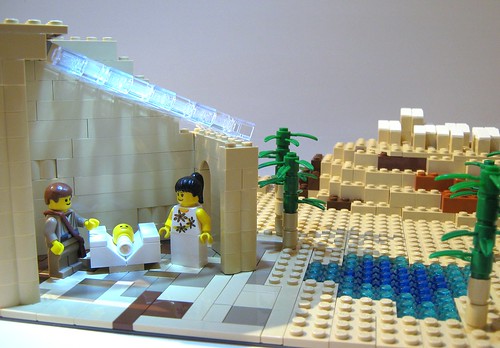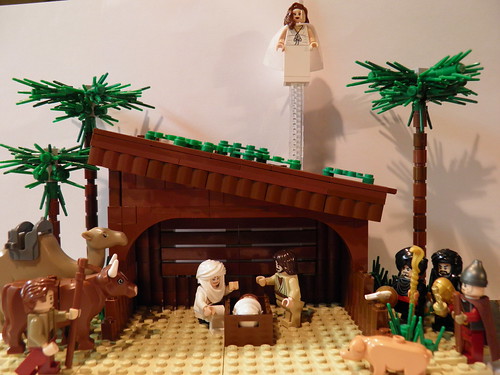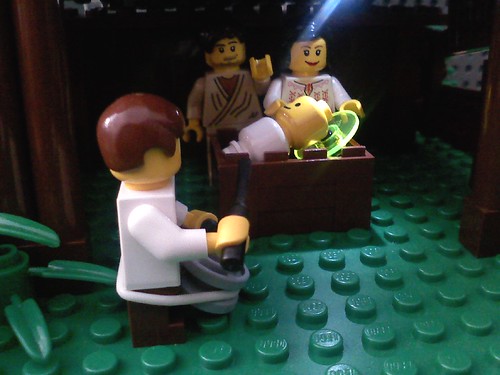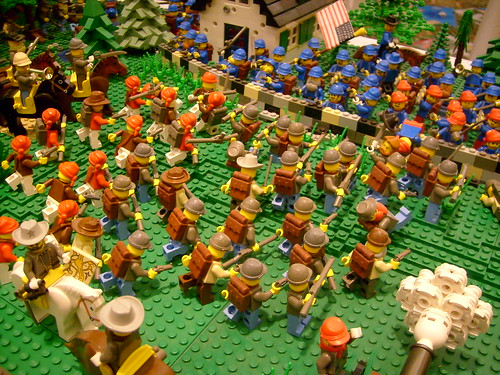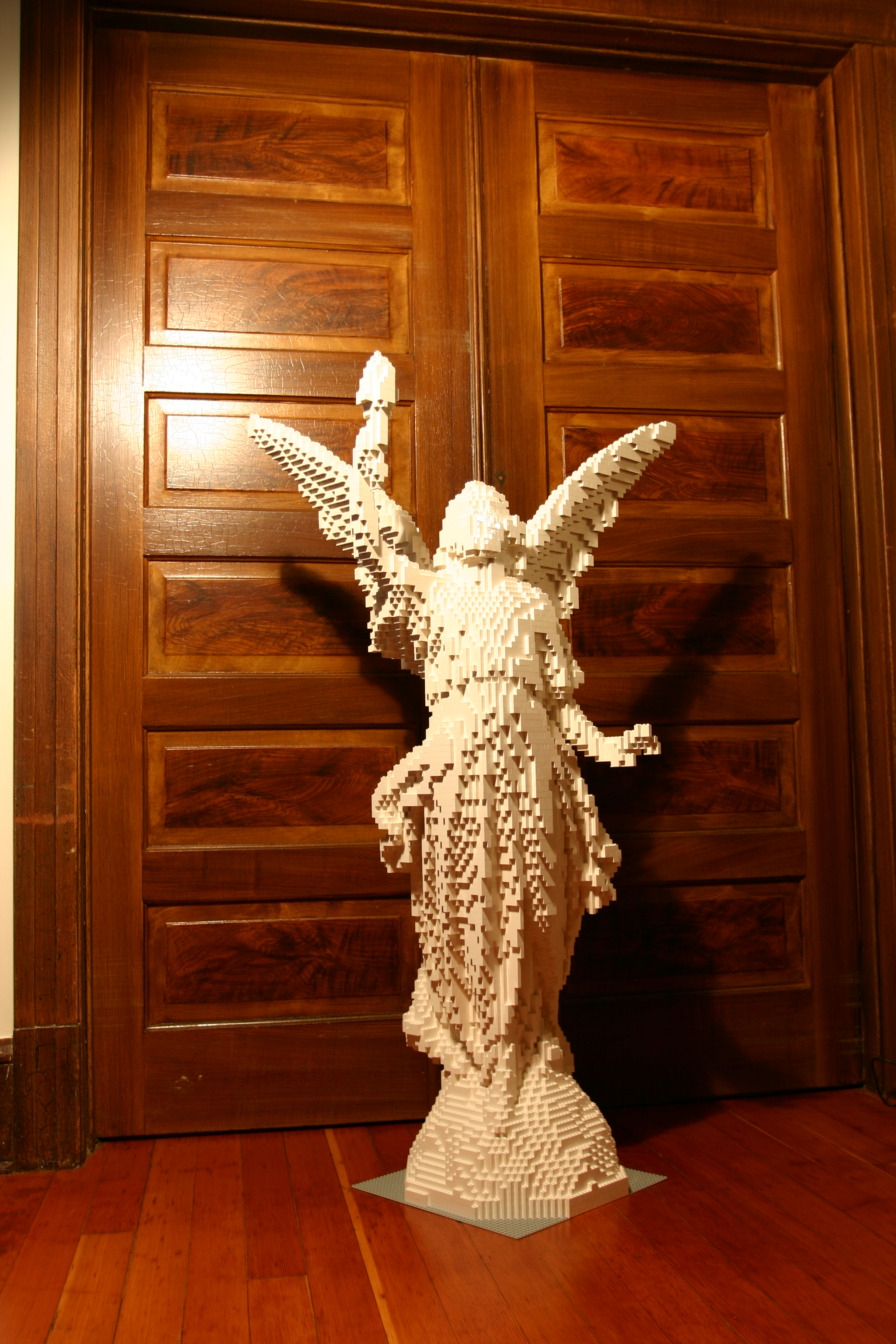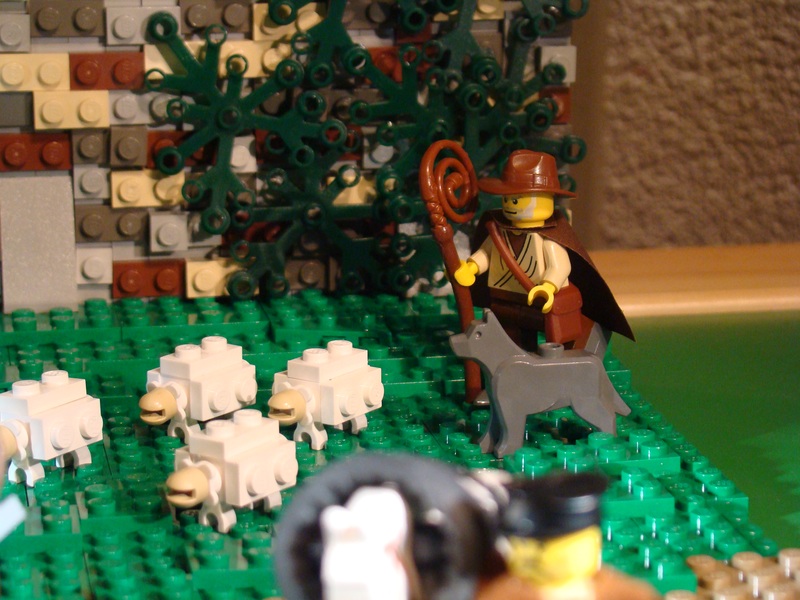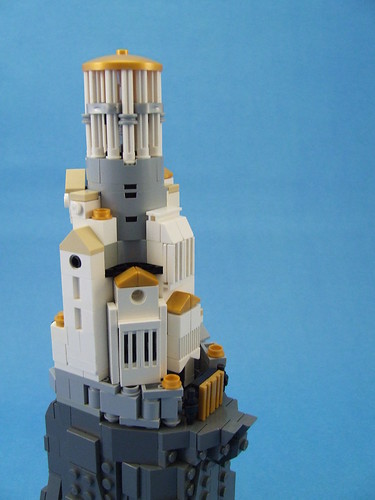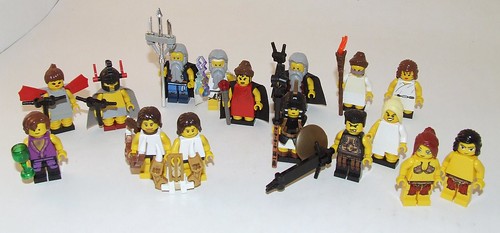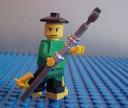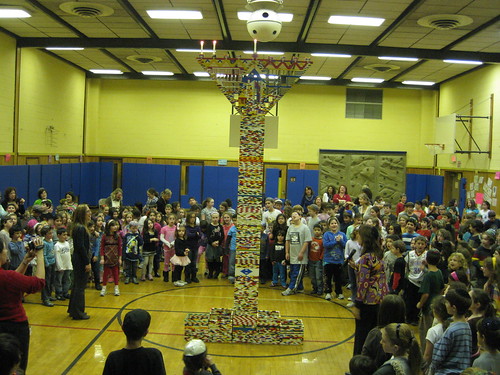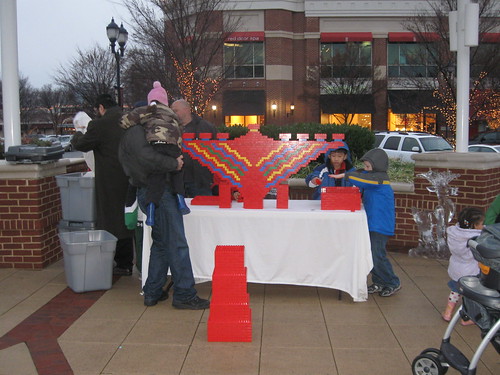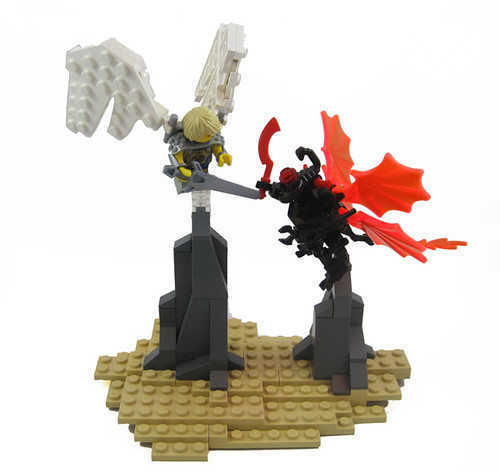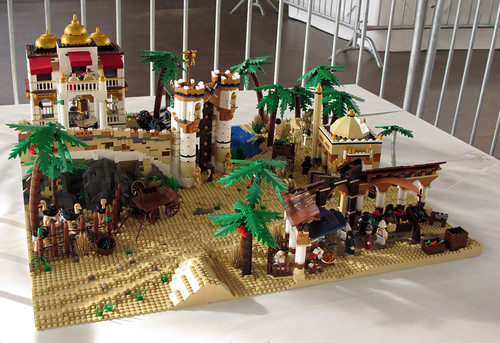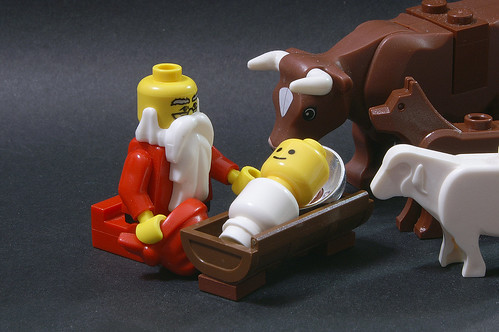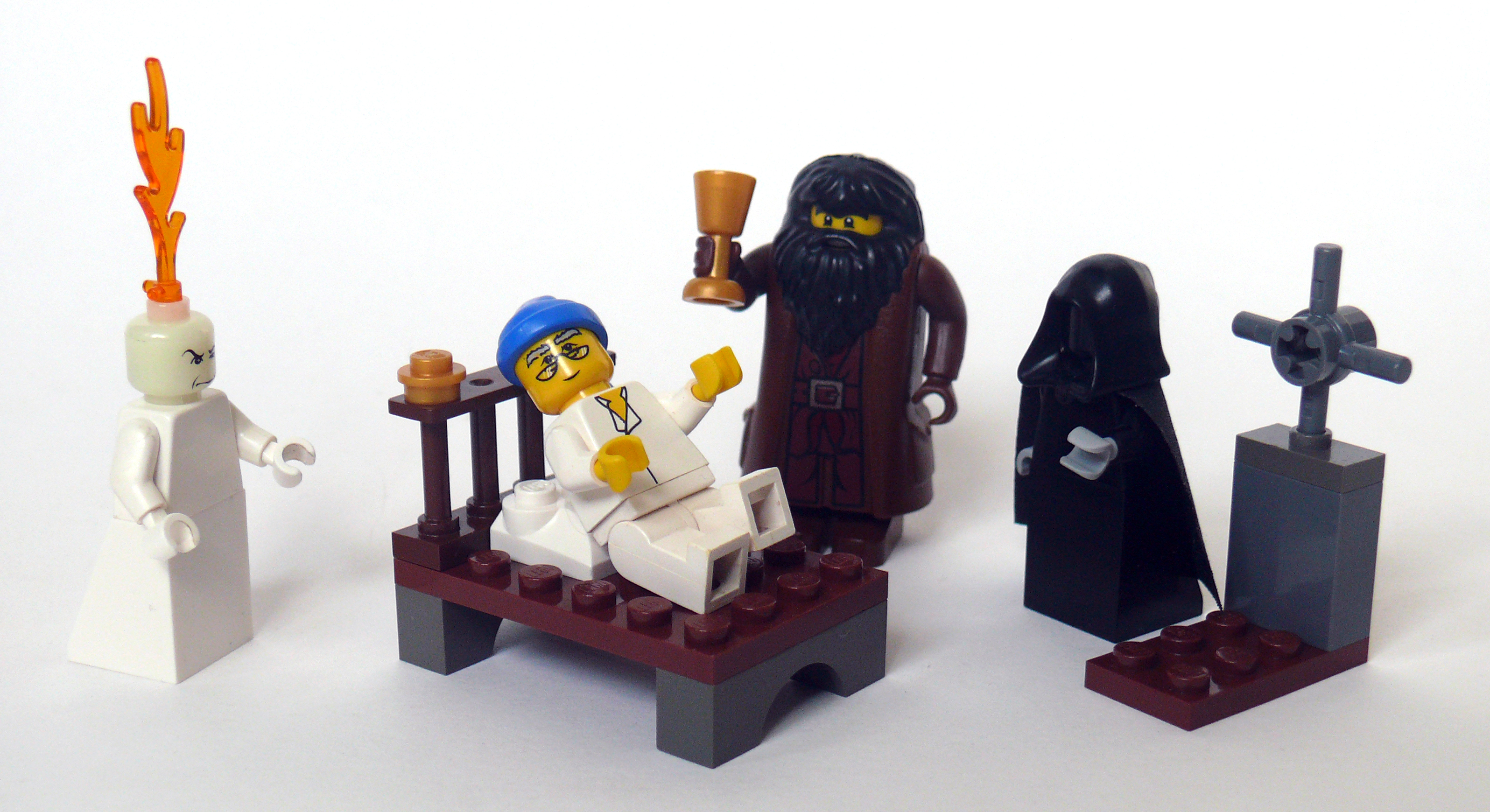As a new feature here at GodBricks, I'm going to have occasional interviews with some of the LEGO builders I've featured. And who better to start with than Brendan Powell Smith, creator of
The Brick Testament? This work is easily the most extensive and most prominent LEGO project devoted to themes relevant to this blog, but from a different perspective. Since Brendan was kind enough to give extended answers to several of my questions, I'm going to break this up into two parts. And so, with no further ado, on to the interview ...

Photo credit goes to
Flak Magazine.
GodBricks: First up, welcome to GodBricks. For the sake of our readers, let me say up front that we've corresponded many times and I've been a fan of the Brick Testament from the very beginning nine years ago. Can you tell me about the original inspiration of this project? Did you intend from the very start to spend many years covering the whole Bible, or was this at first just meant to be a few short stories and then on to other LEGO projects?Brendan Powell Smith: The Brick Testament began life as just another in a string of quirky creative projects I was doing at the time (others included
writing and recording albums, making a 600-page web-based
choose-your-own-adventure game, and writing and acting in a
Christmas movie). To be honest, if any of those projects had gotten the kind of attention and flattering praise that The Brick Testament attracted so quickly, I might still be working on one of those other projects.
When I first conceived of doing the Bible in LEGO, my initial thought was to just recreate a few famous scenes like the Garden of Eden and the Last Supper as LEGO models. But as I started building the Garden and designing minifigure versions of Adam, Eve, and God, I began to realize that I had an opportunity to make not just models for display, but that I could retell the stories of the Bible in LEGO using a series of still photos set inside a fully LEGO-built universe.

Since I was starting with the first story from the first book of the Bible, I thought I'd just go from there and see how things went. The website went online in October 2001 with six stories, from Adam and Eve up to The Flood. Things indeed went well, and now, nine years later, I've put 422 illustrated Bible stories on the website and have had three books published in seven languages around the world.
GB: I know that you are not a religious person. Could you tell us about your own story with regards to faith issues? Why would someone who is not religious spend so much time on the Bible?BPS: I was raised in a family that went to an Episcopal church where my mom was even a Sunday School teacher for a few years. Around the age of thirteen, I went through a phase where I consciously decided I wanted to leave behind what seemed like childish ways of thinking. I didn't start off taking aim at religion. It was more an attempt to weed out
magical thinking and superstition, but eventually I began to see the similarities in how people think about God and especially prayer. It wasn't the most comfortable thing for me to bring skepticism to bear against God at that age, and it was a solitary journey, since I did not know anyone else who was not a believing Christian. But I baby-stepped my way through it with thoughts like, "Well, if there is a God, and he is going to punish me for even questioning these sorts of things, that doesn't seem like a God worthy of my respect in the first place."

Eventually I decided there just did not seem to be good reasons to believe in God, and that it seemed far more likely that no gods exist, and that put me in an odd position. I now felt like I had "seen through" religion, and that I had figured out something that almost everyone else in the world had not, even people who were (otherwise) very, very sharp. This made me fascinated by religion and with why other people found it convincing and didn't see through it the way I did. Was it that I was missing something, or was it really that almost everyone else was?
This curiosity lead me to study religion and philosophy in college, where I learned about the historical origins of Judaism and Christianity, studied the philosophical arguments for and against the existence of God, and first read through the Bible on my own. Reading the Bible was a revelation to me. I was downright shocked by so much of the content and by the overall portrait it portrayed of God. It seemed entirely at odds with the idea of God that most Christians I'd encountered seemed to believe in. I became convinced that most people simply are not aware of the contents of the Bible, and reasoned that it would be a better thing if they were.
So even though I am not religious, I recognize the importance of people being familiar with the contents of the Bible, and I am jarred by the idea that more than 2 billion people identify themselves as Christians or Jews, and yet almost none of them really know what makes up the vast bulk of the book they consider our most important moral guide. The few carefully chosen readings given in churches, and the distorted versions the Bible stories found in children's Bibles and Sunday School lessons were not doing the job, and were actually giving people a false representation of the Bible. So I wondered if there was a way to make the actual contents of the Bible presentable in a way that was fun and engaging, and yet still true to the text. It wasn't until a few years out of college, though, that I happened to get back into building with LEGO as an adult.
GB: Have your own views of the Bible, Christianity, or Judaism changed in any way over the course of this project?BPS: There are a couple of things I've changed my mind about over the years. One of them is the conventional wisdom that says "The God of the Old Testament is god of wrath, while the God of the New Testament is a god of love". To some degree I believed something akin to this for years even after I'd been working on The Brick Testament, though I wouldn't have made the contrast quite so stark. Sure, it's easier to find some more agreeable or even noble ethical maxims in the Gospels, but the life and teachings of Jesus are not without their dark side, and even within the first year of working on The Brick Testament, I made sure to strike a balance between adding material from the New Testament in proportion to material from the Old Testament. I've always sought to keep The Brick Testament safe from the potential criticism that it only highlights some small minority of Biblical material that misrepresents the whole.
It was in re-reading the book of Revelation, though, that it became clear to me that the God of the New Testament was every bit as much a nasty, vengeful God of wrath as the God of the Old Testament. My mind reeled at the sadistic nature of that book, and how warped by hatred and spite its author must have been. It casts a deep, dark shadow over anything positive that might have come before it in the pages of the New Testament, and yet seems in many ways like a perfect close to a Bible whose bulk concerns the God of the Old Testament.

The other change of mind I've had over the years concerns the scholarly quest for the historical Jesus. I studied under Paula Fredriksen at Boston University, and for many years after that I found her view of the historical Jesus to be the most convincing. It is the same view held by consensus of (non-religiously-motivated) scholars, and perhaps best laid out by Bart Ehrman in his 1999 book Jesus: Apocalyptic Prophet of the New Millenium. As that title suggests, these scholars argue that the evidence points to a portrait of Jesus as a Jewish prophet (one of many during that period) who was convinced that God was about to (during his lifetime) bring about a violent end to the world and usher in a radically new age. His code of ethics are therefore best understood as temporary instructions on how to act during the very, very short time remaining.
What's changed for me is that, while I still think scholars like Ehrman and Fredriksen make a strong argument, I have become more persuaded by the interpretation of the evidence by the author
Earl Doherty who, in his book Jesus: Neither God Nor Man, makes the argument that the writings of the first hundred years of Christianity point to an earliest period of the religion that believed in a Jesus / Son of God figure who was purely a spiritual entity, and who was not seen as a human being who had walked the Earth in recent memory. I fully realize this theory strikes most people as a radical notion, and those who haven't read the case for it are quick to dismiss it. In fact, I would even recommend that people read Ehrman's or Fredriksen's books first, since they are a bit more accessible, and provide a good groundwork for comparison. And yet, in the end, I find Doherty theoy has the most explanatory power, leaving fewer important questions unresolved.
But my own assessment of the scholarly quest for the historical Jesus does not really affect my work on The Brick Testament in any significant way. When illustrating the Bible, I always put myself in the mindset that what it says about Jesus it true. It would be the same if I were illustrating The Illiad: even if I was interested in Ancient Greek history enough to become convinced, like most scholars, that King Agamemnon was not an actual historical king of Mycenae, such a belief would not change how I illustrated Homer's epic.
GB: Of course you've gotten tons of press over the years. Can you tell us about some of the response you've gotten from different groups - atheists/agnostics, Christians, Jews, Muslims, The LEGO Group?BPS: The vast majority of responses I've received have been very positive, whether from Christians, Jews, or non-religious folks. There have been hundreds of requests from churches and other religious institutions to use material from The Brick Testament their in presentations and classes. Others who have left the religion they were brought up in tend to appreciate how it brings to light the absurdities and repugnant material in the Bible.
Only about one in every hundred e-mails will have anything negative to say. The most common complaint is that I do not shy away from illustrating the Bible's sexual content in a frank manner, and there is an accompanying worry over the effect that seeing such things might have on children. I am always bewildered that people could be so worried about children being exposed to sexual content, yet not have a far more pressing concern over children being exposed to cruel and violent content. Especially when it comes to the Bible where, sure, there is a little bit of sex content here or there, but the amount of cruel and violent material is just tremendous. It is by far the most violent book I have ever read. I can't understand how someone could fear the effects of children seeing a depiction of two people having sex more than they would fear the effects of children seeing a depiction of torture, murder, or genocide.

I don't know what the reaction of The LEGO Group is to The Brick Testament. I know that there are people who work for LEGO who are fans and have said some very nice things about the project, but I think the company itself would prefer to keep a polite distance, and that's fine with me. While it would be wonderful to get shipments free bricks from them (especially any and all new minifig parts as they come out, wouldn't that be nice?), I don't think they would ever want to be seen as a sponsor of the site, or endorsers of its content, and I would never want to feel beholden to them when it comes to making decisions about its content.
GB: I note Muslims in particular because someone took an image out of context and labeled it as Muhammad having sex. Your depiction of slavery is another image I've seen spread around the web without proper attribution or context. I rather suspect that your depiction of Nazis will eventually share a similar fate. Have you had any personal fallout from things like this? Have you tried to counter this misuse of your images?BPS: I don't know that I've ever received feedback about The Brick Testament from someone who made clear that they are a believing Muslim. I am aware of the
image that was taken from the Judges section of my website and altered by some unknown person (without my knowledge or permission) to depict a fake LEGO set of Mohammed having sex with an underage girl. It had spread to many parts of the internet before it came to my attention. I did make a concerted effort to post a note on any forum or blog that displayed this image, asking them to remove it, and explaining how the original had been altered without my consent. I suppose it's possible for any of my images to get used without my permission in a similar way. If someone can take an image of an Israelite and label it Mohammed, perhaps someone will take the image of the Nazi rally and label it a kibbutz.

I have not had any personal fallout from anything like this so far. Of course, it will be a shame if a Muslim believer kills me because he mistakenly believes I depicted Muhammad in LEGO. But I'm not sure what I could really do to prevent that. That whole issue is pretty insane. Does it make any sense for people to be "tolerant" of the insane and evil belief that someone should die for depicting a certain other person? If Presbyterians believed that people should be killed for wearing blue jeans, and indeed had killed many people who wore blue jeans, should other people show "respect" for that belief and never wear blue jeans? Wouldn't the more sensible thing be to denounce such evil, deranged beliefs and severely punish anyone who acted on them?
A huge thank you to Brendan. Check back in a couple of days for part two of this interview. -GodBrickEdit - Please read part 2 of the interview.

